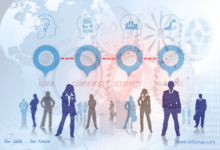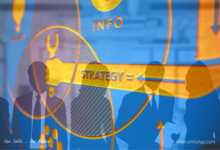
Strategic HRM: “Priorities & Advantages“
Organizations are increasingly adopting strategic HRM processes in business, which focus on aligning HR priorities with the organization’s strategy to achieve maximum results. Strategic HRM constitutes approaches and ideas used by HRM and the organization’s leadership for career development in line with business objectives and strategy. Strategic HR professionals tailor planning, staffing, training, and talent management processes specific to the organization’s broader goals and objectives.
Pillars of Strategic HRM
- Inspiring employees and enhancing their engagement by implementing a clear plan to retain talent, who in turn make a difference to their survival in the organization.
- Promoting a learning and development culture that increases and updates employees’ skills by providing flexible opportunities for continuous training. That leads to compatibility and keeping pace with developments and rapid changes in the business world.
- Develop a clear plan for employees’ professional development that enhances their career path and advancement and clarifies all possibilities for promotions, salary increases, benefits, and rewards.
- Employee data analytics to verify and improve employee performance management by demonstrating their participation and contribution to results.
- Adopting a succession plan that creates future leadership models with new and innovative roles that inspire and motivate employees and allow the flow of fresh and creative ideas.
- Effective communication with employees to have an accurate and precise knowledge of all operations and everything new in the organization leads to continuous improvement.
Advantages of Strategic HRM
Adopting strategic HRM as an essential approach in the organization will inevitably lead to an innovative transformation in operational processes and organizational performance and achieve a competitive advantage. Therefore, many advantages will achieve by adopting this strategic approach, for example:
- The performance of the employees is consistent with the objectives and strategies of the organization.
- Develop HR policies and procedures to become more flexible and transparent.
- Adopting skills as a priority in the recruitment, selection, and recruitment processes.
- Setting performance measures and indicators to ensure employees’ professional development and career advancement.
- Improving the quality of work and job stability through a plan to retain and care for talents.
- Empowering employees and creating a space for participation and exchange of development and creative ideas and proposals.
Strategic HRM Priorities
Implementing strategic HRM benefits both the organization and its employees. Therefore, I suggest following the following priorities while implementing it to be most effective:
1. Analysis of the current HR strategy and the organization’s future needs
HR strategy analysis includes studying the organization’s strengths and weaknesses, evaluating the success of HR operations, and evaluating the organization’s future human resources needs.
2. Align strategies with business needs
The HR strategy should align with the organization’s future strategy and needs. For example, matching skills to job requirements, enhancing teamwork culture, setting performance goals and indicators, developing new policies and procedures, or implementing new technology.
3. Effective Communication
The HR department must continuously and close effective communication with other departments to ensure that the administrative structure flows smoothly between all levels of the organization. Effective communication keeps employees informed of all changes, policies, and procedures. It also helps create a flexible and productive collaborative work environment in which employees feel cared for and appreciated, enhancing their participation in ideas and suggestions.
4. Evaluate and compare HRM’s capabilities with the organization’s objectives.
It is critical to creating a strategy that aligns with the capabilities of HRM because, with the right tools and skills, HR professionals can implement it more effectively. Thus, comparing these capabilities with the objectives of the organization as it allows the discovery of a strategy that the human resource department can implement.
5. Promote continuous learning and development
Learning, development, and training programs can include new policies and procedures, as well as specific skills required for the job because the application of these programs contributes to enhancing the personal and professional skills of employees so that they become an added value to the organization.
6. Adopt Intelligent Technology
can enhance the future trends of HRM and its performance developed through adopting intelligent technology such as artificial intelligence (AI) that contributes effectively to HR analytics. It leads to accuracy and clarity in implementing HR planning and talent retention strategies.
7. Measure results and develop corrective actions
Outcome measurement involves monitoring the success of a strategic HRM plan by monitoring, recording, and analyzing data. It also includes tracking employee turnover rates, measuring employee satisfaction levels, and evaluating employee productivity. Developing and implementing corrective actions is also necessary, as this helps ensure that the HR strategy aligns with the organization’s strategic planning.
8. Conflict management and conflict resolution
HR professionals must master problem- and conflict-resolution skills to deal with employees. Note that solving problems and conflicts between employees must adhere to the ethical and strategic approach to HRM, considering the interest of all with continuing to support the organization’s overall goals.
Strategic HRM is essential for any organization that wants to be successful. After all, people make up an organization and make it a success or failure. Therefore, the systems should make the most of their human capital and achieve the desired results.



